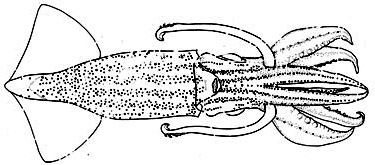Abralia fasciolata
Kotaro TsuchiyaIntroduction
A. fasciolata is a very distinctive species. It is easily recognized by its striped photophore arrangement on mantle. This species is similar to A. marisarabica in the mantle photophore arrangement, buccal rappet connectives and eye photophores, but is easily distinguishable by its larger mature size, and the larger number of integumental photophores on the mantle.Characteristics
- Tentacle clubs
- Two or three hooks on ventral side.
- Two rows of large suckers on dorsal side of manus.
 image info
image info
- Hectocotylus
- Right ventral arm of male hectocotylized.
- Hectocotylus with two very differently-sized flaps.
- Large proximal flaps bilobed.
 image info
image info
- Eye Photophores
- Five silvery organs with three to five minute additional organs in between.
 image info
image info
- Integumental Photophores
- Ventral mantle with six broad longitudinally arranged stripes of integumental organs which become diffuse posteriorly.
- Ventral head with seven longitudinally arranged stripes of integumental organs; unpaired middle row is with few photophores.
- Buccal connectives.
- Buccal-support connectives attached to the dorsal side of Arm III (DDDD-type).
Comment
This species is similar to A. marisarabica and A. dubia in its strange arrangement of buccal connectives and unusual eye photophores.
Nesis (1993) suggested this species is a synonym of the poorly known species, Abralia dubia (Adam, 1960).
Distribution
Geographical Distribution
This species is known only from the type locality, the Gulf of Aqaba, Red Sea.Title Illustrations
Abralia fasciolata, from the Gulf of Aqaba, Red Sea, Tsuchiya, 1991, size, male.
Other illustrations
- Tentacle club, from the Gulf of Aqaba, Red Sea, from Tsuchiya (1991), size, male.
- Hectocotylus, from the Gulf of Aqaba, Red Sea, from Tsuchiya (1991), size, male.
- Variations of the eye photophore arrangement, from the Gulf of Aqaba, Red Sea, from Tsuchiya (1991), .
- Buccal connectives, from the Gulf of Aqaba, Red Sea, from Tsuchiya (1991), size, male.
About This Page
Tokyo University of Fisheries, Konan, Minato, Tokyo
Page copyright © 2000
Citing this page:
Tsuchiya, Kotaro. 2000. Abralia fasciolata . Version 01 January 2000 (under construction). http://tolweb.org/Abralia_fasciolata/19664/2000.01.01 in The Tree of Life Web Project, http://tolweb.org/








